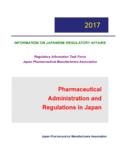Transcription of Implementing the UK Five Year Antimicrobial …
1 Implementing the UK Five Year Antimicrobial Resistance Strategy 2013-2018 Professor Neil Woodford AMRHAI Reference Unit, PHE Crown copyrightAMR poses a catastrophic threat 2 FCO (Russia), 20th February 2017 Crown Copyright3 The Scale of The Challenge 25,000 people per year in Europe die of infections caused by resistant bacteria 23,000 deaths/year from sepsis caused by resistant bacteria in United States (a conservative estimate). Globally, by 2050 drug-resistant infections could cause 10 million extra deaths a year and have a cumulative cost of US$ 100 trillion In the UK 5,000 patients die of Gram-negative sepsis each year, half with a resistant resistant bacteria are spreading in the UK and world resistance and a lack of new drugs means a risk of infections that cannot be treated and more deaths unless urgent action is (Russia)
2 , 20th February 2017 Crown CopyrightScientists kick back, 2016 There is undoubtedly a large clinical and public health burden associated with AMR, but it is challenging to quantify the associated excess morbidity and mortality. Current global estimates of the burden of AMR are not very informative; we need detailed, reliable data to be able to improve AMR control measures, preferably based on comprehensive, population-based surveillance data from low-, middle-, and high- income countries. The AMR Review even acknowledged that the reported numbers are broad brush estimates, [.]
3 ] that more detailed and robust work will no doubt be done by academic researchers, and that there is a lack of data, urging for improvement of infection surveillance. 4 FCO (Russia), 20th February 2017 Crown Copyright5 The UK Five Year Antimicrobial Resistance Strategy, 2013-2018 The overarching goal of the Strategy is to slow the development and spread of AMR. It will do this by focusing activities around three strategic aims to: improve the knowledge and understanding of AMR; conserve and steward the effectiveness of existing treatments, and stimulate the development of new antibiotics, diagnostics and novel therapies.
4 FCO (Russia), 20th February 2017 Crown Copyright6 Specific focus of the UK AMR Strategy PREVENT (people from being infected infection prevention and control) PRESERVE (the antibiotics we have good stewardship) PROMOTE (development of new antimicrobials, new approaches, better diagnostics the independent review by Lord Jim O Neill)Underpinned by: Surveillance R&D One Health approach International collaborationFCO (Russia), 20th February 2017 Crown CopyrightThree strands for surveillance of on consumption of antibiotics in both humans and animals, [.]
5 ] which would help understand the link between Antimicrobial use and the development of resistance. on resistance rates for various drug bug combinations and their impact on patients health. biological data to explain the biological basis of resistance, through characterisation of the types of resistant bacteria and the genetic reasons for their resistance..This information should be gathered within a one health perspective, covering animals and humans and the environment to provide a complete pictureFCO (Russia), 20th February 2017 Crown Copyright7 HCAI & AMR surveillance 8 FCO (Russia), 20th February 2017 Crown Copyright9UK AMR High Level Steering Group The UK programme is overseen by an Interdepartmental High Level Steering Group (HLSG), chaired and supported by the DH.
6 The Government cannot deliver the actions alone, contributions are needed across sectors:Human Health and Social Care Livestock, food retail and veterinaryResearch councils, other research funders and academicsThe pharmaceutical industry. The group drives change, ensuring there is progress across all sectors and that momentum is maintained. FCO (Russia), 20th February 2017 Crown Copyright10 The role of Departments and their agenciesDH - lead on research prioritisation and collaboration, international collaboration; managing global funds; signposting to clinical trial platforms.
7 Overall strategy coordinationDefra - coordinate activity relating to the animal health and environmental aspects of the strategy including IPC, prescribing practice, reducing Antimicrobial use in livestock production in real - coordinate activity relating to the human health aspects, working with Defra re the human/ animal health interface; support on IPC, prescribing, evidence based behaviour change interventions and England - working with NHS Improvement to deliver ambitions for improved IPC and antibiotic prescribing in the NHS, utilising levers and incentives to ensure that improved IPC and reductions in prescribing are sustainable.
8 Delivery of the vision for diagnostics and Improvement mobilising providers of care in local health systems and holding providers to account. FCO (Russia), 20th February 2017 Crown Copyright11UK 5 year AMR strategy implementation programme, structure chart UK AMR Programme Management Office, DH Global Public Health GroupUK AMR High Level Steering Group (HLSG)Meets three times a year to drive and oversee delivery against strategic aims. Tasked with publishing an implementation plan, detailed outcome metrics and an annual report on : Vacant; Members: PHE, Defra, DH, BIS, DFID, DAs, PHE, NHS England, NHS Improvement, NICE, HEE, MHRA, FCO, CO, (HMT), Diagnostics and AMR, Chaired by Sue HillAMR policy and coordinationDH leads on 3 action areas: new drugs, treatments and diagnostics; research and international.
9 DH AMR Programme Group oversee DH led : Helen Shirley-Quirk (DH)Expert Advisory Groups - ACDP, ARHAI, DARC, by DH, Defra and FSA to undertake specific work, including outcome measures, to support the Cross -Whitehall International Steering GroupResponsible for delivery of the international element of the UK AMR : Julien Braithwaite FCO. DH, Defra VMD, DfID, BIS, Health and Social Care sectorsPHE leads coordination in 4 action areas across England; IPC, optimised prescribing, awareness and surveillance. SRO: Paul CosfordPHE AMR Programme Delivery Board.
10 Meets 6 weekly. 11 PHE work-streams report into the group. Chair: Duncan Selbie. NHS England, NHS I, HEE, NICE, RCGP, RCN, Defra, DAs, LGA, ADPH, ARHAI, VMD, RCPath, AMRC, DH Animal Health, Agriculture, Food and the EnvironmentDefra leads on animal health, agriculture, food and the environment . SRO: Pete BorrielloVMD leads on animal health aspects across the StrategyNHS England AMR Strategy Implementation GroupSRO: NHS Improvement: SRO: Mike DurkinAMR Research Funders Forum The Medical Research Council leads to coordinate and align efforts in AMR research.







